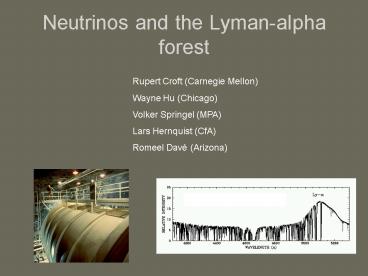Neutrinos and the Lymanalpha forest - PowerPoint PPT Presentation
1 / 27
Title:
Neutrinos and the Lymanalpha forest
Description:
... spatially, so that measuring properties of F will give us properties of ? (such as P(k) ... problem is that the photoionization rate may fluctuate spatially: ... – PowerPoint PPT presentation
Number of Views:30
Avg rating:3.0/5.0
Title: Neutrinos and the Lymanalpha forest
1
Neutrinos and the Lyman-alpha forest
Rupert Croft (Carnegie Mellon) Wayne Hu
(Chicago) Volker Springel (MPA) Lars Hernquist
(CfA) Romeel Davé (Arizona)
2
Plan
- -The Lyman-alpha forest
- How to use it to measure clustering of the mass
- Potential changes to the simple picture
- -galactic winds
- -radiation fluctuations
- Constraints on the neutrino mass derived from
the - Lyman alpha forest in 53 Keck spectra.
3
Neutrinos suppress power spectrum of mass
fluctuations on small scales.
Hu, Eisenstein and Tegmark (1998)
We would like to measure linear clustering on as
small a scale as possible
4
Small scale structure in the IGM distribution at
z3 (33 Mpc/h box)
5
Star formation at z3 in the same volume
6
- The atomic transition which is most useful for
finding - material in absorption is the Lyman-alpha
transition - of neutral hydrogen.
The energy levels of the Hydrogen atom
- This is the transition from the 1s to the 2p
level.
- An atom in the ground state which absorbs a
photon - with the correct energy will move to the excited
state. - -for Lyman-alpha, the photon with this energy
has a - wavelength of 1216 Angstroms.
7
- If we take a spectrum of a quasar, we can see
material - in absorption
- Light travelling to us from the quasar gets
- redshifted by the expansion. When the
- wavelength of light gets to the Lyman-alpha
- wavelength, there is a probability that a
- photon will be absorbed by neutral hydrogen
- gas at that redshift.
Ly-alpha emission line at quasar redshift
8
Fe-t
The Lyman-alpha forest can give us a 1D map of
the density field
9
Fe-t
We rely on A not fluctuating spatially, so that
measuring properties of F will give us properties
of ? (such as P(k))
10
Temperature of baryons
Density of baryons in units of the mean.
11
We measure power spectrum of quasar flux and
convert to mass power spectum using calibrating
simulations.
12
The temperature of the IGM influences the
turnover in the power spectrum on scales
comparable to the thermal width of lines. - we
exclude data on the smallest scales.
13
Test of the procedure on a simulated universe
which contains hot particles with total mass
5eV.
14
Our current models of the IGM can reproduce many
observations. However, they ignore the possible
effect of
galactic winds
and
the discrete nature of photoionizing sources
(the radiation field is not uniform.)
15
New simulations (Springel et al 2002) include
addition of kinetic energy to gas close to SN in
galaxies creates wind particles. -these can
spread metals into the Lyman-alpha forest to the
degree observed. - what is their effect on the
clustering?
16
(No Transcript)
17
Another problem is that the photoionization rate
may fluctuate spatially
This will happen if the UVBG is generated by
discrete sources, such as galaxies or
QSOs. However, the mean free path of an ionizing
photon is 100 Mpc/h at z3. This is much larger
than our 33 Mpc/h hydro simulation volume. -we
will investigate this effect by combining with a
large 500 Mpc/h dark matter run.
18
We raytrace photons through the density
distribution of the simulation. -quasar sources
are taken be at the positions of density peaks
-quasar LF from Pei (1995)
Source
19
(No Transcript)
20
State of the Universe 100 million years after the
turn on of a quasar with lifetime 10 million
years.
21
Quasars with lifetime 100 million years
22
Quasars with lifetime 10 million years -green
points are dead quasars
23
(No Transcript)
24
From Croft, Weinberg, Burles, Bolte, Hernquist,
Katz, Kirkman and Tytler (2002), ApJ Dec 10th
issue.
25
To determine relative suppression on small
scales, we need to constrain amplitude of matter
fluctuations on large scales. We also have the
measurement in km/s at z3. The relationship
between this and lengths scales at z0 depends
on cosmology Additional constraints used to meet
both these objectives (a) cluster
abundance constraint on s8 (95 range 0.7-1.13
for Om0.35) (b) COBE normalization on
large scales. (c) Universe is flat
(d) Shape of P(k) on scales 0.025 h/Mpc to 0.25
h/Mpc given by PD94 (e) Also we use BBN
BT99 constraint on Ob and HST KP constraint on h
(but neither has any power to change
results).
26
We rule out all regions of parameter space where
on constraint is violated by 2 sigma (we do not
multiply likelihoods together).
27
Conclusions
The Lyman-alpha forest is quite robust
-galactic superwinds at z3 can propagate into
the underdense IGM but dont affect the majority
of Lya forest clustering. -UVBG fluctuations
may cause the flux P(k) to vary by up to a factor
of 10 on large scales, but not on the scales
that have so far been used to constrain the
neutrino mass. The Lyman-alpha forest is a
useful probe of power in the mass density field
on small scales. -combined with other
constraints to tie down the large scale end, we
find that M? lt 4.5 eV for all values of Om.
-for Om lt 0.3, we find M? lt 0.7 eV































